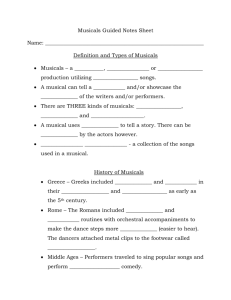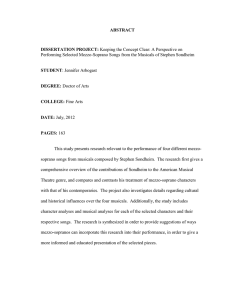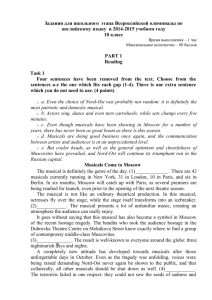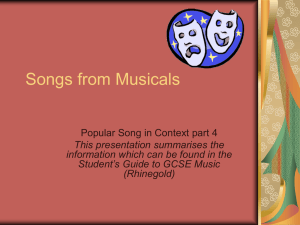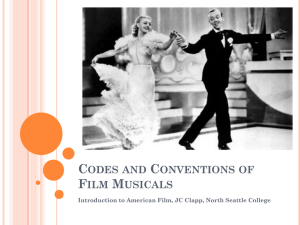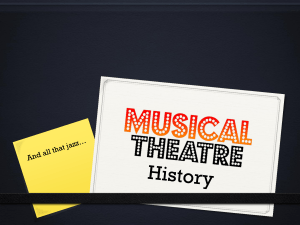C F M ODES AND
advertisement
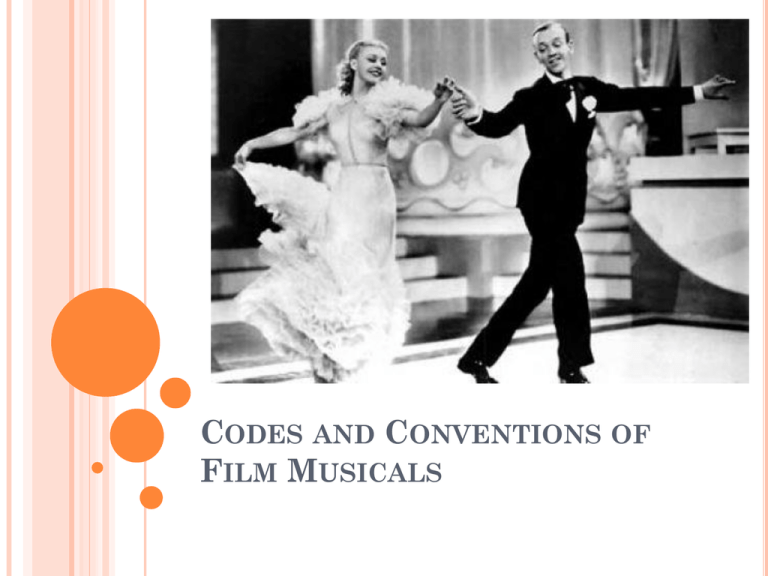
CODES AND CONVENTIONS OF FILM MUSICALS OVERALL STYLE & CHARACTERISTICS Songs sung by the characters to advance the plot or develop the film's characters or themes. Singing in a movie isn’t what makes a musical – for it to be a musical, characters must be uninhibited and outwardly express emotion through song and dance Rather than simply adding music to the soundtrack (non-diegetic), the characters within the film sing and dance to convey their thoughts and feelings (diegetic). MORE STYLE & CHARACTERISTICS Characters sing and dance to the camera, for the benefit of the film viewer, rather than any ostensible audience within the film's story. Musicals are always set in a fantasy world of some sort where music appears out of nowhere, where extras spontaneously act as back-up dancers, where everybody has a booming Broadway-style singing voice NARRATIVE AND THEMES Overall, musicals tend to be utopic and happy where good rules over evil – or where the protagonist prevails Whether the characters in musicals are feeling up or down, whether they are alone or in public, they are always able to fulfill their desire or to feel better by dancing or singing. MUSIC OF MUSICALS The musical accompaniment comes from "no where"— outside the world of the film—though the singing comes from within the world of the film, which is a violation of the rules of realism that govern almost all other genres/styles. Songs are usually “Broadway” style requiring big, powerful voices Singing originates from the mind and emotion of the characters – the songs are used to express inward thoughts and feelings outwardly SETTING Musicals have been set in many different times and places and are embedded in many other genres. Typically, there are big, lavish, colorful, over-the-top sets -the scenery can often change from a realistic picture to something more dreamlike. Often musicals look like they are set on a theatre stage – reminiscent of Broadway theatre musical productions CHARACTERS Male Lead: Protagonist, hero Female Lead: Protagonist, often the love interest of the male lead Villain: Usually an adult male, or often the conflict comes from the protagonist’s struggle against a life adversity (poverty, finding way home, unsympathetic family, forbidden love, desire for something unobtainable) Sidekicks: Side/ancillary characters that round out the narrative and support/thwart the protagonists AND NOW . . . AN INCREDIBLY BRIEF AND INCOMPLETE HISTORY OF AMERICAN FILM MUSICALS . . . MUSICALS IN A VARIETY OF GENRES/STYLES Western = Annie Get Your Gun, Oklahoma Mystery = Drood War = South Pacific, Hair Science Fiction = Little Shop of Horrors, Chitty Bang Bang Fantasy = Mary Poppins, Wizard of Oz Documentary = This is It Biography = Musical Biography of Quincy Jones Horror = Sweeney Todd Comedy = The Mask, Singin’ in the Rain Action/Adventure = Labyrinth, The Great Race Family Drama = The Sound of Music, Annie, Seven Brides for Seven Brothers, Newsies Teen = Grease, Hairspray, High School Musical, Westside Story Adult Drama = Dream Girls, Saturday Night Fever, Dancer in the Dark, Moulin Rouge!, Chicago Children = Cinderella, Alice in Wonderland, Peter Pan, The Lady and the Tramp, Sleeping Beauty
